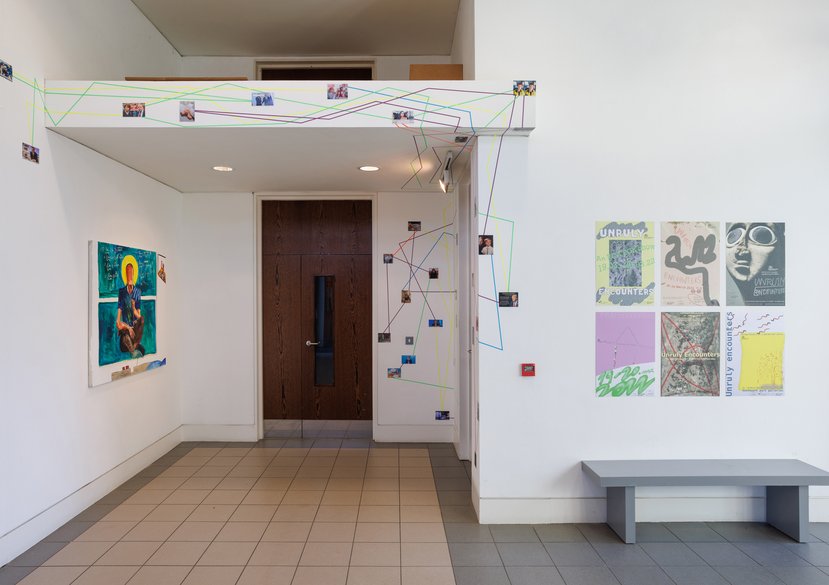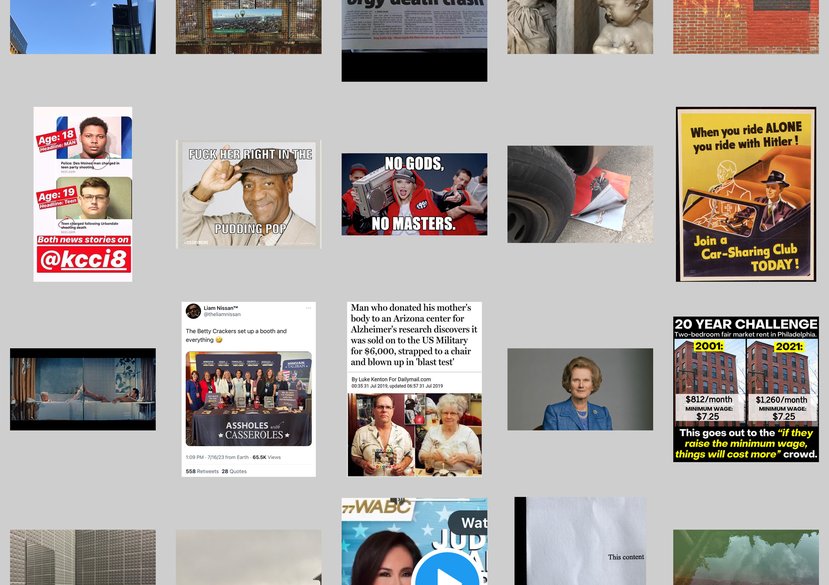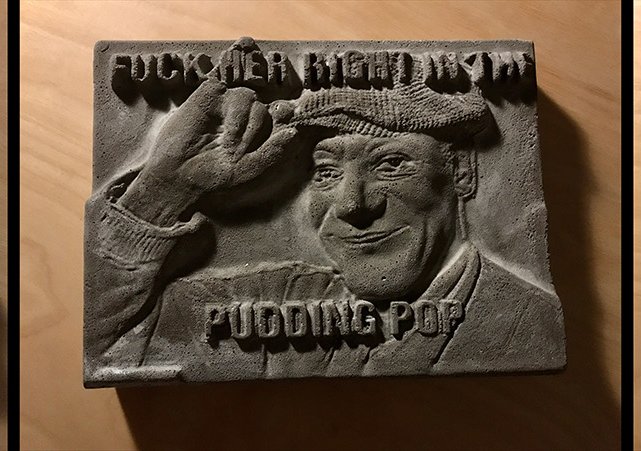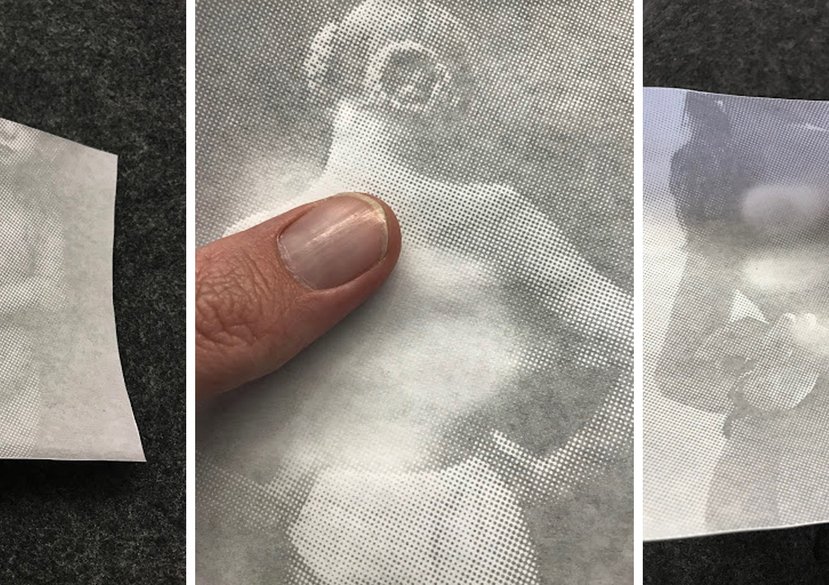
(Dis)connecting dots, (un)making meanings: how images occupy (and are occupied by) language
This practice-led research takes as its subject embodied discovery and the photographic object - its media, language, encounters, and systems of meaning-making. The fundamental questions of my research are these: how does embodied logic shape photographic meaning-making, and how can image encounters manifest this logic?
Periodically throughout this work I switch between personal, analytic, and pseudonymic voices. This is both to employ the concepts at hand in a practical way, but also to provide a method for additional questioning of texts - thus linking metaphoric structures are shown to pervade different writing genres and systems of communication.
The first chapter deals with the closest and most immediate of physical encounters - that of touch and the embodied haptic. Taking as its catalyst my work touch piece, a series of photographic child nudes by famous photographers and reproduced on plain paper, photocopy-style, with heat-reactive thermochromic pigments, this section unpacks the implications of the primary embodied metaphors ‘intimacy is closeness’, ‘seeing is touching’, and ‘understanding is grasping’. Tracing the examples of these metaphors through texts by Gilles Deleuze, Michel Foucault, WJT Mitchell, Marquard Smith, and Mark Paterson and visual works by Amber Hawk Swanson, Caravaggio, Jean-Léon Gérôme, and F. Holland Day, the conflation of physical proximity with emotional involvement ultimately manifests again in the touch piece work, implicating the viewer in an unsought, uncomfortable intimacy.
Progressively zooming out, the second chapter takes on many types and ramifications of networked images in the most expansive understanding of the term. It begins with my work Toward a unified field theory of photography, an analogue image map of assorted pictures I’ve aggregated wrapping the wall, floor, and ceiling and connected by colour-coded lines indicating formal, conceptual, or content-based connections. Exploring the primary embodied metaphor ‘similarity is closeness’, this part brings together folk theories of contamination, proximity, and relational thinking regarding photographic networks, systems, and sorting devices. Chapter II analyses the psychologically networked image via Isabella Stewart Gardner’s art collection and exhibition ethos, Lacanian optical device metaphors, and digital tagging systems, as well as the writing of Jean-François Lyotard, WJT Mitchell, Pierre Bourdieu, and Mieke Bal.
Moving out even farther (while simultaneously looping back to the immediate intimacy of the body) the third chapter deals with the spectre of timespace and death that grounds photography. Led by my works All This and Nothing More, a deep textural analysis of the surface patina of a Polaroid image of my late mother during the aftermath of cancer and the birth of her last child, and Cenotaphs, a series of Internet memes and clickbait detritus immortalised as bas-relief sculptures, this section engages works such as the 1954 George Cukor/Judy Garland film A Star is Born, Zeno’s Paradox of the Arrow, and Stan Douglas’s still and moving Monodramas. Tracing back the embodied metaphors ‘time is motion’, ‘change is motion’, and ‘states are locations’, this final chapter will wrangle with photography’s ineffable connection to the infinite and encapsulation of human mortality.
Arguing for an expanded field of the photographic medium, this practice-led research forms the invisible and often unconscious ‘connective tissue’ that contributes to the image’s facility to create meaning spontaneously. The (dis)connections in the title refer to my own efforts to slow or frustrate this unconscious facilitation in order to bring it to light, offering new ways of understanding the stickiness of image objects and their attendant psychological and physical encounters.
Key details
School, Centre or Area
Supervisors
Gallery
More about Cole
Biography
Cole Robertson is an American artist, educator, and occasional writer/curator. Born in Phoenix, he lived 15 years in Chicago. He lectured for years at the School of the Art Institute of Chicago in the departments of Photography and Art History, Theory, & Criticism. His artwork deals with photography - its languages, objects, histories, and systems of image delivery/organisation. Cole’s research deals with photography as it intersects with embodied language and metaphor. Taking myriad forms (including 3D printing, installation, digital systems, and fine printing), his work has been exhibited throughout the US and abroad. He received six artist grants from the City of Chicago, one from the Illinois Arts Council, and one from the Arizona Commission on the Arts. Cole recently completed a PhD at the Royal College of Art in London.
Degrees
MFA Photography, Columbia College Chicago, 2008; BFA Photography and Art History, Arizona State University, 2003
Experience
MA Group Lecturer, Royal College of Art, 2019-20; Visiting Artist Lecture, University for the Creative Arts Farnham, 2019; Visiting Artist Lecture, Bath Spa University, 2019; Visiting Artist Lecture, Liverpool Hope University, 2018; Instructor in Departments of Photography and Art History, Theory, & Criticism, School of the Art Institute of Chicago, Chicago, 2010-13; Adjunct Professor in Electronic Visualization, University of Illinois Chicago, Chicago, 2009; Adjunct Professor in Photography, College of DuPage, Glen Ellyn, 2007-2009
Awards
Red Mansion Prize (shortlist), 2018; Vermont Studio Center Artist in Residence, 2016; City of Chicago Individual Artist Grant, (2016, 2012, 2011, 2009, 2008, 2007); Illinois Arts Council Individual Artist Grant, 2013
Exhibitions
Citation, European Artistic Research Network international conference, Leeds Art Gallery, University of Leeds, 2019; Another Land: Experimental Visualisations of Place, Stanley Picker Gallery, Kingston University, 2019; Flight Mode, Assembly Point Gallery, London, 2018; Property, Roman Susan Gallery, Chicago, 2017; Lesbian, Gay, Bisexual, Transgender, And Queer (LGBTQ) Caucus Film Festival, Society for Photographic Education National Conference, Las Vegas, NV, 2016; Modular: Nasim Hantehzadeh & Cole Robertson, Mana Contemporary Chicago, IL, 2016
Conferences
‘touch piece’ and other thoughts on the body haptic, European Artistic Research Network international conference, University of Leeds, 2019; 'Connecting Dots, Making Meanings; Photography's Unconscious Networks', International Conference on the Image (theme: Artificial Images and Visual Intelligence: Seeing in the Age of Big-Data), Hong Kong Baptist University, 2018




